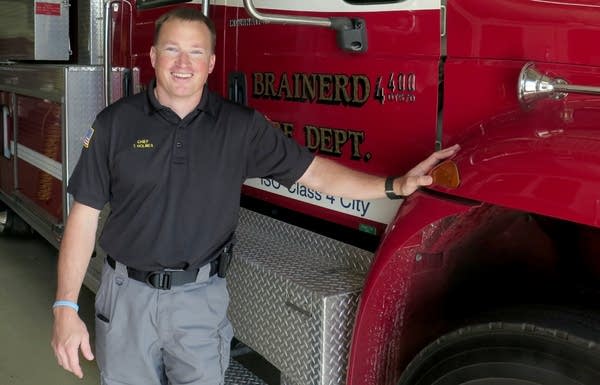Fire trucks or firefighters? Brainerd cuts show tough choices

The 75-foot ladder truck Brainerd bought for its fire department in 2007 arrived in pretty good economic times, so the cost was relatively painless and the truck filled an important community need.
That decision seemed easy. It also seems like ancient history.
Months after the city bought that truck, Brainerd and the rest of the country fell into the Great Recession. Nearly eight years later, the economy's better. However, big-ticket decisions like buying a new, needed firetruck, remain difficult. Brainerd, like many Minnesota cities, is struggling now with how to structure its fire department to meet public safety — and a budget.
Brainerd is taking a strikingly different tack than other cities. To free up money for equipment needs and to make the department's budget more sustainable going forward, the Brainerd City Council recently voted to cut all five of its full time firefighters. The department instead will use dozens of paid on-call firefighters headed up by a full-time chief and deputy chief.
Create a More Connected Minnesota
MPR News is your trusted resource for the news you need. With your support, MPR News brings accessible, courageous journalism and authentic conversation to everyone - free of paywalls and barriers. Your gift makes a difference.
The move will save the city an estimated $250,000 a year, but that doesn't mean officials like it.
"This is gut wrenching," said City Administrator Jim Thoreen. "We don't like to do this, but faced with the realities of the finances, we're moving ahead."

The lingering question in Brainerd is whether the move will compromise public safety. Lance Davis, one of the firefighters losing his job this month, says it will.
"Response times are going to increase. And they're not only going to increase by a couple minutes, but they're going to increase dramatically," he said.
Full-timers are already at the station when a call comes in, so they can leave almost immediately, while volunteers must first drive to the station, he noted. "Then they have to get directions on what exactly they're doing and what equipment to take, then they take the equipment if they've got a crew, and then they go to the scene."

Fire Chief Tim Holmes concedes there will be a change in response times, but says the restructuring will not jeopardize the community's safety and the need for new equipment is clear. The ladder truck bought in 2007 would cost about $500,000 today, he said. And for something a little bigger? "Close to $1 million," he said. "Yeah, it's not cheap."
Minnesota has the second largest percentage of non-career fire departments in the country. It also has the fewest career firefighters per 10,000 people in the United States at 3.57, according to data from the U.S. Fire Administration and University of Minnesota.
Indeed half of Minnesota's 781 fire departments are staffed by paid on-call firefighters, the model Brainerd is adopting. Another 36 percent are all-volunteer departments.
Not all Minnesota departments are moving in the same direction as Brainerd. This year Brooklyn Park hired 18 full-time firefighters. Shakopee, Eagan and other cities have also added full-time staff.
"When you have a purely non-career department, and you're counting on people living on the pager and dropping everything at home, at work, out to dinner, whatever, to respond to the station, and then respond to the scene, you never know from one day, one part of day, one day of the week, what week of the month, what kind of response time you're going to get," said George Esbensen, Eden Prairie fire chief and the incoming president of the Minnesota State Fire Chiefs Association.

Those concerns about more consistent response times were part of what led Roseville to bring on six full-time firefighters in March.
Roseville Fire Chief Tim O'Neil says there's another reality pushing the department that way: It's getting a lot tougher to find recruits. Many potential volunteers work elsewhere in the metro and can't quickly respond to emergencies. Others are busy with work and family demands. And even when he recruits them, O'Neil says, they're often difficult to retain.
"We were hiring 10 to 12 people a year, about 80 percent would wash out in the first three years," he said. "And that would be after we invested tens of thousands of dollars in their training, gear, and uniforms, and it just became kind of a revolving door."

Brainerd hasn't had that problem, says Holmes. At least not yet, because of people like Jonathan Lemieur.
He's one of the city's 38 paid on-call firefighters. And he's a busy guy. He directs consumer lending at Minnesota Federal Credit Union. He's the father of three young girls. On top of that, he estimates he works up to 10 hours a week responding to emergency calls, or going through training. But he says it's worth it.
"Being part of a team, a group of guys, and giving back to the community. Being there to help and serve others in a time of need, is just a great feeling," he said.
But many chiefs say they will need to continually reevaluate how best to respond to calls, when there are fewer people like Lemieur willing to make that commitment.